The "Extended Play" Generation
We took fullscreen pan-and-scan movies in VHS quality and PURPOSEFULLY decreased that quality by 200%. And we loved it.
Vintertainment (this Substack) has always been a hybrid. Part WineStack, part FilmStack, and even part ComicsStack and MusicStack and BookStack, etc. So we can be a little late to any given Stack party.
All of FilmStack proper is of course well aware of
and 's recent challenges to bring FilmStack closer together, especially concerning the topic of "how to rescue cinema". In her conclusion, Sophie imagined theaters as "cultural gyms" and challenged FilmStack writers to whip up 5 films that would represent a "Progressive Workout" (where you increase the intensity with each workout/viewing.)I've thoroughly enjoyed reading everyone's take on this concept, even if I have reservations on how much a theatrical experience tailor-made for cinephiles can truly entice (and not intimidate) a wider public. But hell, if Letterboxd can become a global sensation because people were stuck at home, "Cultural Gyms" can become the same now that they're not.
And there is no question that theaters have to become something more than the current home movie experience. And that got me thinking: what has this "home movie experience" been, historically?
One memory led to another, which led to one internet deep dive after another, and so naturally I wrote this not-so-short article to explore the home movie context of our current moment. Because it's fun and nostalgic to do so, but also, hopefully, this will prove as much food for thought to others as it did to me, remembering how far we've come and what we've always been up against in terms of our home movie experience mentality.
WHEN THE MEN HAD BIGGER TITS THAN THE LADIES
We’ve of course been here before, facing this exact same crisis. Twice, in fact. The 1950s brought about the first major advance and embrace of home viewing technology that threatened the survival of movie theaters: that darn television set.
The original Crisis in Infinite Homes (apologies not apologies to DC Comics) was the proliferation of the TV in every home circa the 1950's, which caused a sharp decline in box office attendance. Celebrities flocked to work in the new medium. Money poured into station programming and less into film studios. In response to this, Hollywood created new-fangled visual formats like Cinemascope and VistaVision, Eastmancolor (which expounded upon Technicolor), and stereophonic sound systems, all of which spotlighted the grandeur and spectacle of the theatrical experience vs. that of a the small b&w box you could watch things on at home.
Studios focused on movies of epic scale and spectacle (and bloated budgets.) THE TEN COMMANDMENTS and BEN HUR were films the likes of which had never before been seen. The stars began to build themselves the bodies of Greek gods (or at least demi-gods) with bulging pecs and biceps, regularly shirtless, the women equally showing more skin, as much as then-current mores allowed.
At the 1949 premiere of SAMSON AND DELILAH (starring Victor Mature, Hedy Lamarr, and Angela Lansbury), the great Groucho Marx was asked by the film's director, Cecil B. DeMille, what he thought of the epic picture. Marx stated:
"Well, there's just one problem C.B. No picture can hold my interest where the leading man's tits are bigger than the leading lady's!"
So: extremely expensive epic extravaganzas in new-fangled visual formats, new-fangled audio systems, unreal sexual aesthetics, and action or (in the case of the extravagant musicals of the time) dance sequences to bring down any house? Sound a lot like the current superhero / M:i / John Wick era of 3D / IMAX / 70mm screenings, doesn’t it?
THE EXTENDED PLAY GENERATION
The next crisis to hit was home video - VCRs and VHS tapes. Two things Hollywood tried to outlaw outright, so much was the perceived threat.
I'm part of what I call the "Extended Play Generation" - kids who grew up on video tapes with 3-4 movies crammed onto them via the wonder that was the "Extended Play" option. To explain this to those under the age of 40: a VHS tape would typically have 2 hours of playtime on it. This was in "Standard Play" (SP) format. But you could choose to instead record in "Extended Play" (EP, also sometimes called "Super Long Play" or SLP) and then the tape would manage 6 HOURS OF RECORDING TIME!1
Of course, when you triple the amount of data being recorded onto a tape, you are also decreasing the video/audio quality of that data by the same ratio.
Let that sink in.
We're talking about movies already cropped to fullscreen pan-and-scan aspect ratios, then recorded in the quality available on a typical home VHS tape, then CONSCOUSLY DECREASING THAT QUALITY BY TWO HUNDRED PERCENT, and calling this our "home video library".2
And folks: we ate that shit up and asked for more.
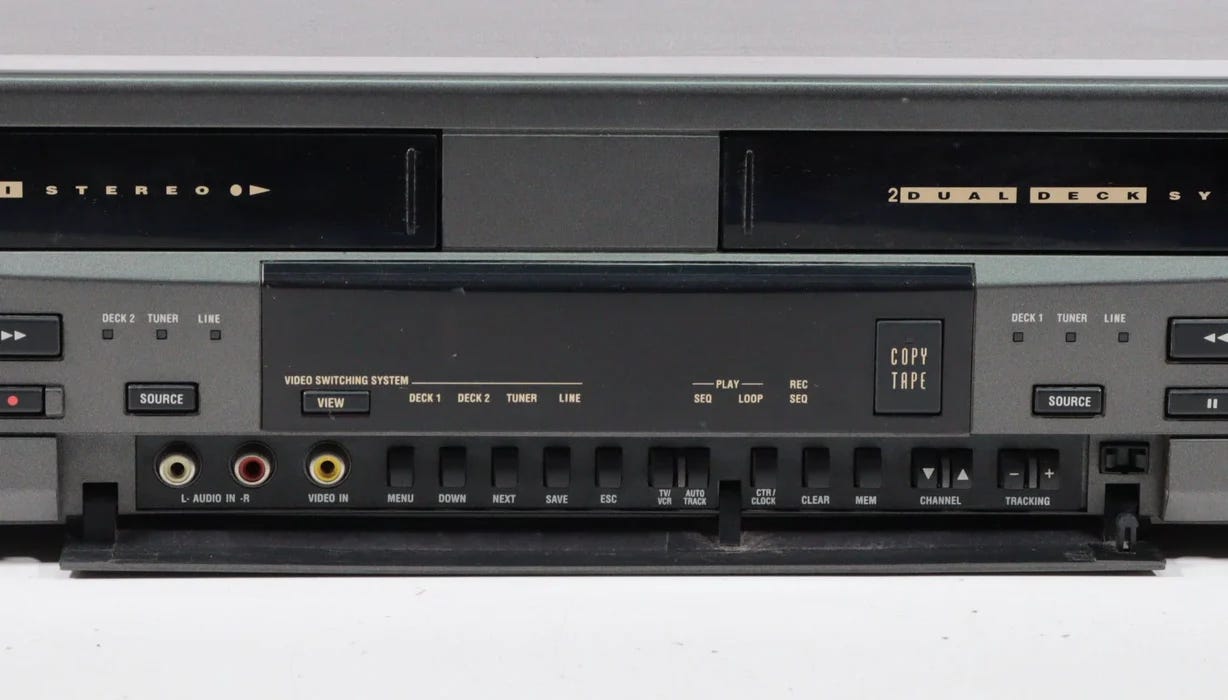
My own family accrued roughly 120-ish VHS tapes, all holding 2-4 films on each (depending on the length of said films). Every tape had a catalogue number stickered onto its slipcase. We racked the tapes in numerical order, and then we had a print-out that catalogued all our movies in alphabetical order and which numbered tape we could find it on. Then the slipcase spine also had the movies listed in order as they were recorded on the tape and the timestamp where each began.
We were really, really into it.
Below is an example of the quality difference between SP and EP, and this is a cartoon. Animation is less effected by visual quality increases or decreases. But here you can see: the color is mostly bleached out of the picture, and the solid drawn lines are often broken - the recording quality simply demanded that much information be dumped in order to fit it onto the tape!
And suburbanites weren't the only ones. Martin Scorsese himself owned a massive VHS collection of rare films, many recorded in EP/SLP.
"Long before YouTube and Netflix gave the world instant access to a deep repository of media, Scorsese began the project of amassing his own private on-demand video library. In each week’s TV Guide, he would note the movies and shows that caught his interest. A full-time video archivist in Scorsese’s New York office would then record the telecasts from a kind of audiovisual hub made up of multiple VCRs and monitors, which could often be active at all hours. The tapes were meticulously labeled, cataloged initially using a library-like card system and later a computer, and filed away for Scorsese’s personal viewing and research."
He accrued over 4,400 distinct titles in this fashion. But in the 2020's, Scorsese began slowly donating his collection.
"The wide availability of high-resolution DVD and Blu-Ray, as well as the rise of streaming, had diminished the usefulness of much of the hulking tape archive."
Even Francis Ford Coppola - the man who just announced that his latest MEGALOPOLIS would forego ANY home video availability whatsoever, including physical media, but would remain a theatrical experience alone - at one point he was an eager early adopter of HD-VHS (yes, you read that right.)
Pre-dating the Blu Ray / HD DVD wars:
"D-VHS uses high-density vidcassettes to store images and is currently the only high-definition homevid format available in the U.S. Several competing high-def DVD systems are in the works, but none is expected to reach market in the U.S. until late 2005 at the earliest."
Coppola released his box office bomb ONE FROM THE HEART on the D-VHS format in hopes of having audience see it in "top quality" for the first time since the theater, which of course no one actually attended, at least not for this movie. D-VHS was quickly outperformed by the digital disc HD formats, but the point being is that even the auteurs were wild about this home video stuff, both for their own personal libraries and for their own work.
Which has us step back in time a touch further to realize:
THE AUTEURS OF THE 1970's BECAME WHO THEY WERE BECAUSE OF TELEVISION
From the Scorsese article, regarding his VHS collection:
"The collection is also a physical manifestation of his famously omnivorous appetite for visual media. Scorsese has frequently spoken about growing up asthmatic in a New York City household that lacked books but was one of the first on the block to get a television set in 1948, when he was six years old. For young Marty, who wasn’t able to play in the streets as frequently or vigorously as other kids, the 16-inch screen of the black-and-white RCA Victor in the living room became his window to the world – and, critically, his first exposure to great cinema."
Television was the OG threat to theatrical experience. The 1950's saw homes across the world install TV sets and suddenly the peak of cinema ticket sales (in term of sheer numbers of tickets sold) was well and truly over. Yet, it was this very television thang that created a generation that became not just theater goers, but cinephiles, obsessed with...cinema.
The "Auteurs" of the 1970's, as they were later to be called, were the first generation to be FANS of cinema. They were the first wave of American artists to see working in cinema as something to aspire to and expound upon. And this was because movies were native to them - not just at the cinema, but they were raised with a TV in their households, and the ability to live and breathe them every single day. They could come from families of modest means, yet watch films over and over, notice the names in the credits, watch programmed runs of films on particular channels. Scorsese, Coppola, De Palma, Spielberg, Lucas, Cimino, Cronenberg - these were young men who had come to adore cinema, and wanted to be filmmakers to build upon the work of Orson Welles, Alfred Hitchcock, Cecil B. DeMile, William Castle, etc. And certainly, going to the cinema was a critical part of that love. But arguably more critical was the ability to wade so deep into the artform it became part of their identity.
WE BECAME WHO WE ARE BECAUSE OF "EXTENDED PLAY" (AND LATER, STREAMING)
The theatrical experience found a way to survive and thrive, though the public never tired of TV - they were more than happy to watch plenty of programming on this short, compact aspect ratio often with no color and mono sound.
VHS Home Video was the beginning of consumers being able to have their own movie library. It was a hands-on venture, too, as copying VHS's was highly illicit (if not illegal - FBI Warnings, anyone?) and you had to get around copyright protection technology, VHS vs. PAL formats, region coding when DVD's dropped, but the thing is, the public always found a way to get around these things.
Even today, with streaming, not much has changed. VPN allows us to watch other territories' streaming selections. Programs exist to record directly off Netflix or Amazon Prime or most streaming apps. ("HDTV Rips", as they call them, are common to find on torrent sites.) Programs still exist to bypass Blu Ray and 4K copyright protections.
And I find myself being proud of my digital "library" of owned titles - digital copies that I purchased to own. Many quirky ultra-indie titles or remastered rarities the purchases of which I made to support the releases of. I have a physical library as well, and in both cases I back up the movies I most care about with digital copies, because whether a digital file you don't personally house or a physical disc that can be lost, damaged, or degraded over time, neither is meant to last forever.
"Streaming" is of course the current crisis facing theaters, but it isn't the first, and won't be the last. And I thought it important (or at least interesting) to recognize just how far home movie watching has evolved since the previous crises, and how much of a compromise people have always been willing to accept for the convenience of watching a movie at home. How much they, in fact, no longer need to compromise on at all!
Streaming is now HD, even 4K - not as tippity-top quality as physical media or a DCP or 35mm at a theater will give you, but this is where it's important to remember that most of us fell in love with cinema because of VHS tapes and television replays. Not because we spent our every hour of free time (or even movie watching time) at a cinema.
This is not meant as a defense of streaming services - they have their pros and cons and as corporate entities are only interested in the welfare of their shareholders and executive bonuses. Though don't get me started on giant Multiplexes when it comes to theaters - these have never been and are not our friends, either. Not to the viewer and not to smaller theaters.
Back in 2005, at the peak of DVD3 sales, 35,000 movies had been released on the format. Comparatively, there are now over 250,000 movies available to stream on any given day now (this included individual rental and purchase, not just subscription streaming.) That is a difference of epic scale.
THE POINT OF ALL THIS BEING
Watching movies at home has come an insanely long way. We have never been particularly picky about the quality of our home movie consumption. Most of us became movie-obsessed because we had access to so much, so often, more so than ever before in film history. Prior to TVs and home video of any kind, cinephilia and true fandom of the artform was rare.
The theatrical experience IS special, and distinct from home viewing, no matter how wide your screen, surround your sound, or 4 your K. But our need for this home viewing experience and all that we gain from it should not be undervalued, either. We are plainly in a cultural moment of streamer (mostly) and home movie backlash. Theaters themselves, notably the giant multiplexes, have only made their own situations more dire and forced us to defend what are uaually equally as indefensible monopolies of the space.
The plus side to home movie viewing is that its very nature - the sheer wealth of content available and how often we can consume it - is the very thing that might make theaters as “Cultural Gyms” possible. It transformed Letterboxd from a quiet cinephile corner of the interet to a general public online venue. And likewise, it can make Cultural Gyms as hot a thing as Gym Gyms - which, arguably, took off thanks to the at-home workout craze of the 80’s and 90’s.
There is a way that these two things co-exist and feed into each other. I’m not sure if the major studios or major multiplex chains will ever be a part of that vision - how streaming came to cannibalize itself thanks to studios flooding the market with their individual apps too late in the game to make it work but they did it anyway, is another article for another time. But this article is a glance back and celebration of everything that home movies have given us.
I don’t miss my family’s shitty, shitty extended play VHS library. But I sure did fall in love with every single movie I saw as part of it. Here’s to more of that for all of us, however we ultimately take it in.
There was also an intermediate option called “Long Play” or LP, which got you 4 hours of recording time. But almost nobody used that. Just in case you needed more evidence that humans are all-or-nothing creatures.
It’s important to note that VHS tapes were prohibitively expensive at the time. So if you were buying a blank one, you WERE going to get 6 hours out of that shit.
Can we also take a moment to remember when DVDs first introduced “Letterboxed Widescreen” to consumers? This was a movie finally being shown in its fully wide, nothing-cropped glory, and we HATED IT. Until my parents upgraded to their first widescreen TV, they adamantly swore that parts of the picture were missing from widescreen films! Because there were “black bars” on their TV when there hadn’t been before! (Even when anamorphic, if the TV was still fullscreen box-sized, the “black bars” had to show necessarily. We really had to be weaned off VHS/TV style home movie watching. Somehow, we still went to the theaters, then watched the same movies at home with 2/5ths the picture missing (at least) and never noticed the difference, and even resisted the return of the fully wide picture. This is what home movie viewing has always been. Just keep that in mind the next time you’re trying to argue how much more picture grain you get on a 35mm print or between a Blu ray vs. a compressed HD streaming copy. Cuz that argument probably ain’t gonna get you very far.




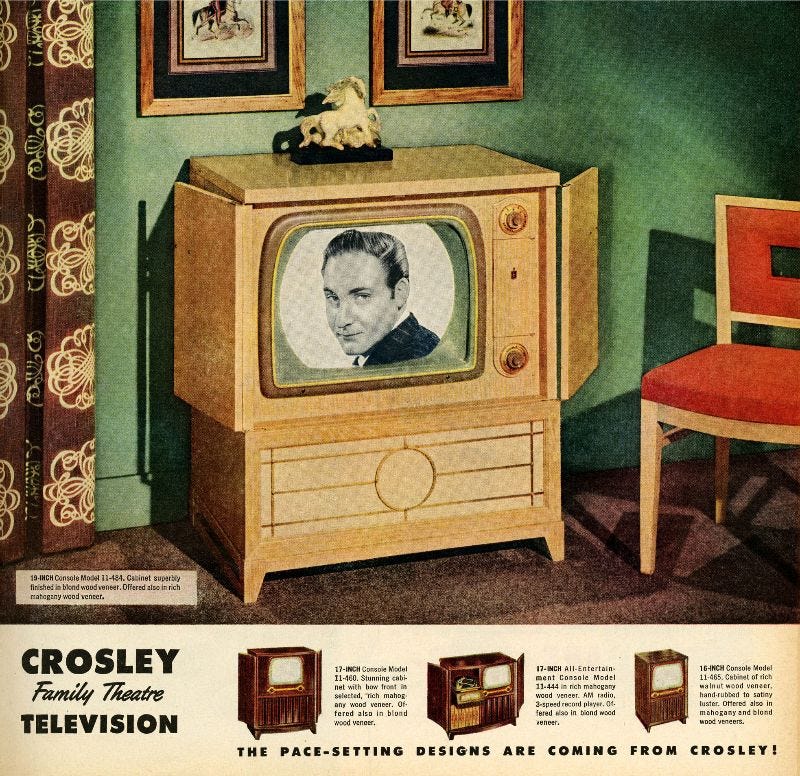
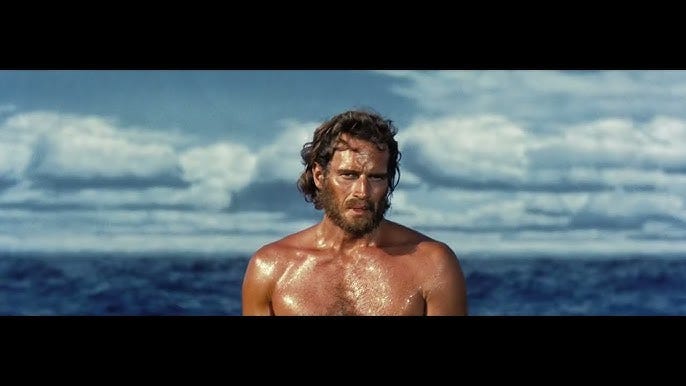
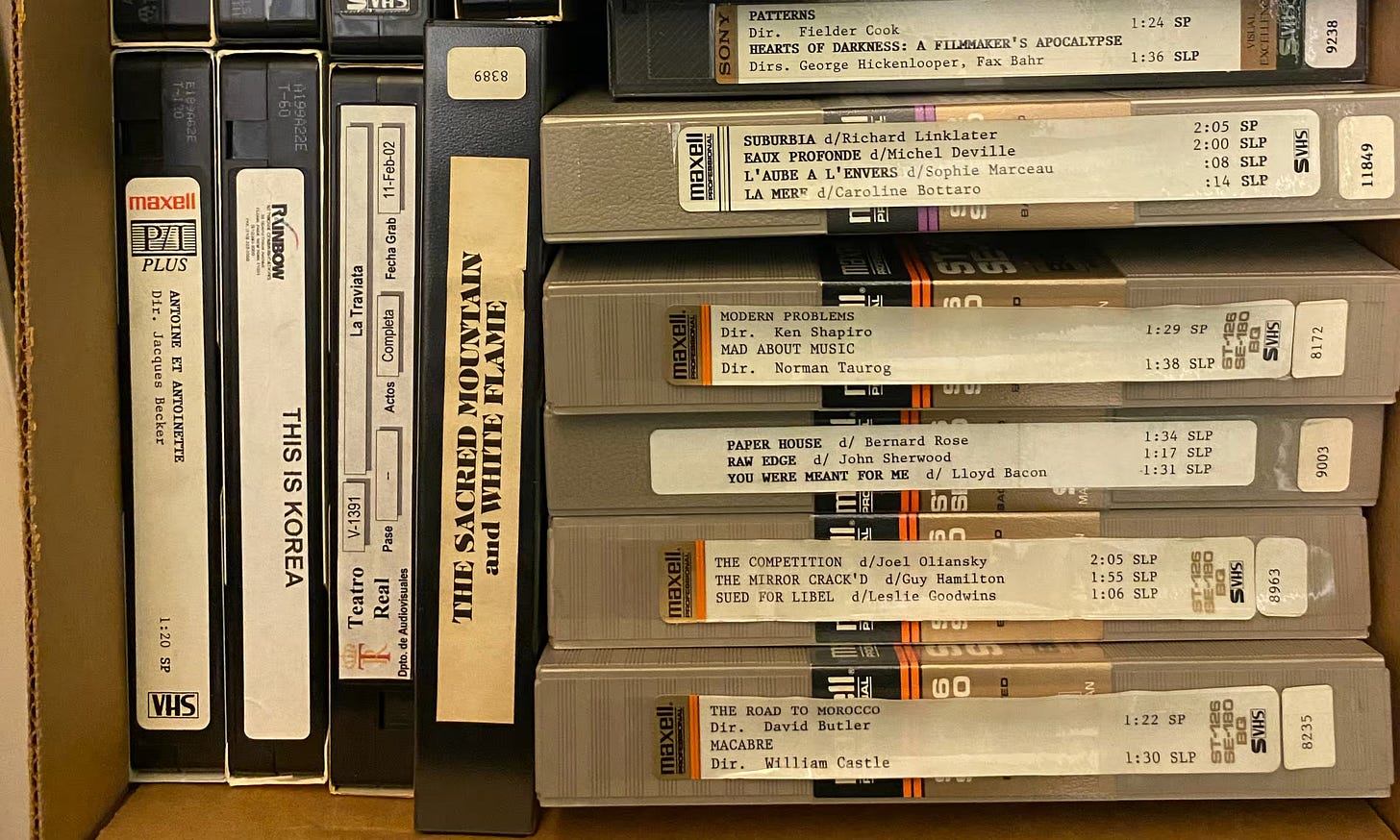
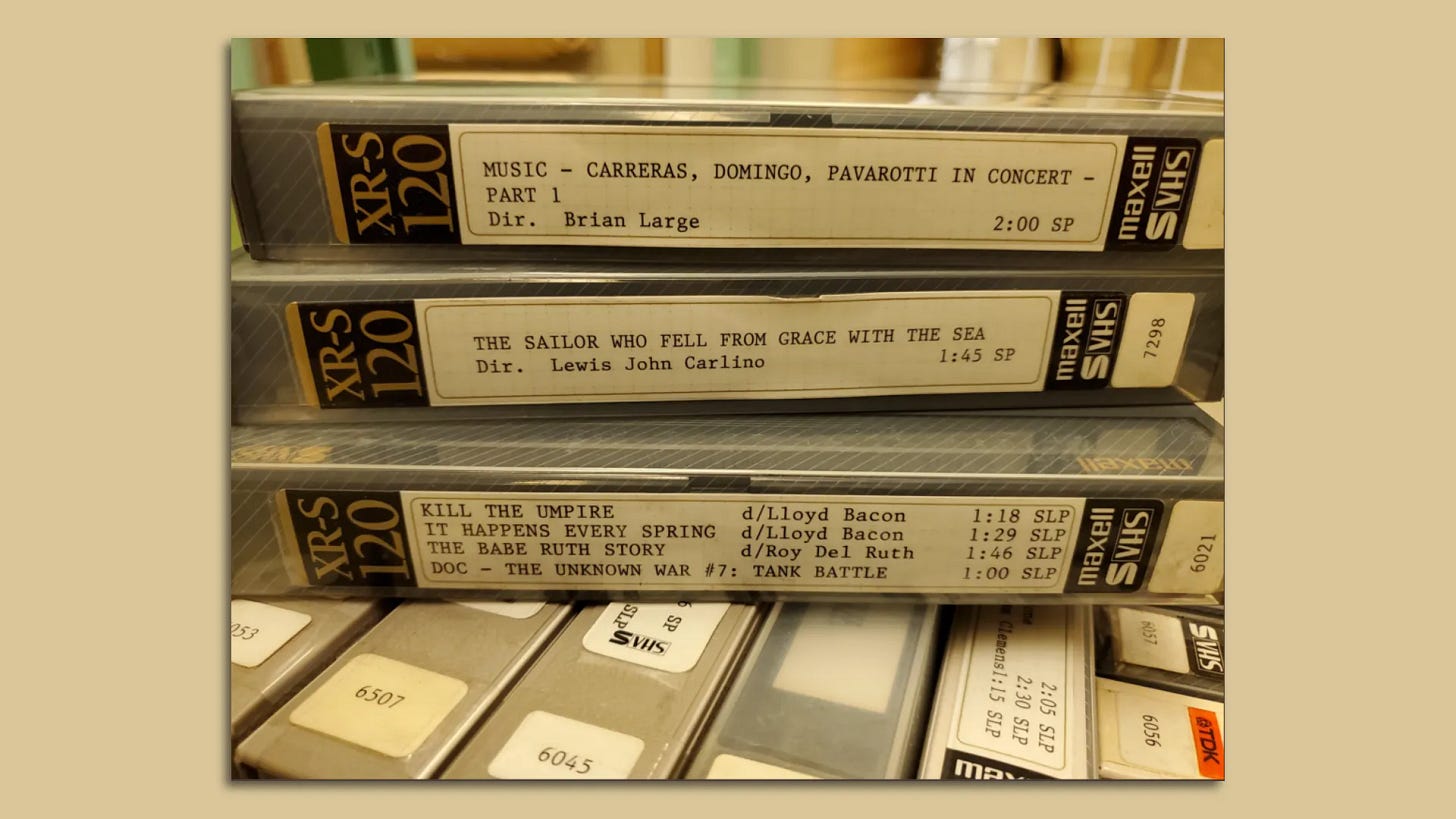

Thank you for this trip down memory lane. Also: very much miss the commentary tracks that came with DVDs. That was a secret window into filmmaking which is now completely absent these days.